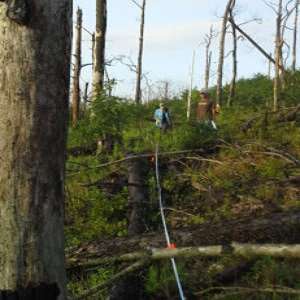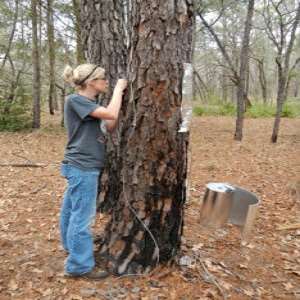Without human help, the “Lost Pines” may lose some of what it is known for after wildfire ripped through that region almost six years ago, according to a Texas A&M AgriLife study.

The “Lost Pines” ecoregion, located in Bastrop, Fayette and Caldwell counties, constitutes the western-most range of loblolly pine in the U.S. This patch of pine-dominated forest is isolated from the rest of the East Texas Piney Woods by over 100 miles.
Due to the concern about this unique region and specifically Bastrop State Park, Caitlyn Cooper, an agronomy doctoral student at Texas A&M University, and her advisers conducted a two-year study to look at burn severity and soil type and the effect of the two on oak and pine growth and water use.
Joining Cooper on the project are Dr. Georgianne Moore, Texas A&M department of ecosystem science and management associate professor; Dr. Cristine Morgan, Texas A&M department of soil and crop sciences professor; and Dr. James Muir, Texas A&M AgriLife Research forage scientist at Stephenville.
Cooper said she found the pine trees were reestablishing themselves where the fire severity was light to moderate. However, where the fire was severe, there had been a shift to more post oak and blackjack oak growth.

A mix of post-oak resprouts and pine seedlings are found in a moderately burned plot. (Texas A&M AgriLife photo by Caitlyn Cooper)
“Our concern was that resprouting oaks may alter resources and make conditions unfavorable for pine reestablishment,” she said. “We designed an experiment to test the effects of fire severity and soil type on the growth and leaf-level functions of resprouting post oaks, blackjack oaks and loblolly pines, hoping to better understand the physiology of the three species and how their long-term recovery may be affected.”
In July 2015 and 2016, Cooper and two other students measured resprout heights and diameters and collected leaf samples for nitrogen, carbon and phenolic compounds that would provide an indication of plant stress response.
“We took measurements in three soil types ranging from deep sands to shallower rocky soils and replicated those measurements in each soil type and burn severity combination three times for a total of 18 plots,” she said.
In 2016, the project expanded to include additional measurements to analyze foliar photosynthesis, water potential and hydraulic characteristics, which would increase understanding about water access and use by the three species, Cooper said.
Marco Minor and Ashley Cross, Texas A&M University students who help with the project, set up a plot in a severely burned patch to measure loblolly pine seedling and oak resprout heights and diameters. (Texas A&M AgriLife photo by Caitlyn Cooper)
“We found that the degree of burn severity had more of an effect on growth than soil type,” she said. “Pine seedling densities were much lower in severely burned areas than those that had experienced light burns. Oak resprout densities were similar across burn severity, but the trees were smaller in the moderately burned plots than those that were severely burned.
“Reduced resprout growth in moderately burned plots may be due to increased competition with loblolly pine since we encountered a greater number of pine individuals in moderately burned areas than those that were severely burned.”
Although the pines tended to be shorter than the oaks in 2015, they had similar heights to the resprouts by 2016, she said.
“Our leaf-level measurements suggested that the oak resprouts were better able to tolerate drought stress, while the pine seedlings were more conservative with water use and exhibited drought-avoidance characteristics,” Cooper said. “Post oak was more tolerant of drought stress than blackjack oak.”
In addition to the plots for evaluating oak resprout and pine seedling competition, Cooper established three sites to compare sap flow, a way to measure water use. Two of these sites were established in Bastrop State Park in moderately and severely burned regions, and the third was established at an unburned site at the Griffith League Ranch north of Bastrop.
“After the fire, we wanted to see if there was a difference in tree stand water use,” Moore said. “Plant density affects competition, and that affects how much water is available to individual trees.”
Caitlyn Cooper, an agronomy doctoral student at Texas A&M University, installs sap flow sensors in a loblolly pine at the moderately burned sap flow site. (Texas A&M AgriLife photo)
Cooper said they found a few of the overstory oaks and pines were killed, but the majority lived at the moderately burned site. The entire overstory had been destroyed at the severely burned site. This site used much less water than the unburned and moderately burned sites due to the large reduction in tree density and size.
“We also found that mature pine trees use more water than mature oaks,” Cooper said. “So if the severely burned area returns with more oaks than pine in the future, it will likely continue to use less water than pine-dominated stands in other parts of the park. That, in turn, could mean more runoff.”

Initially, she said, that runoff is not a good thing because of the erosion it might cause, but as the land heals, it will leave more water for other plants.
Click here to see more...